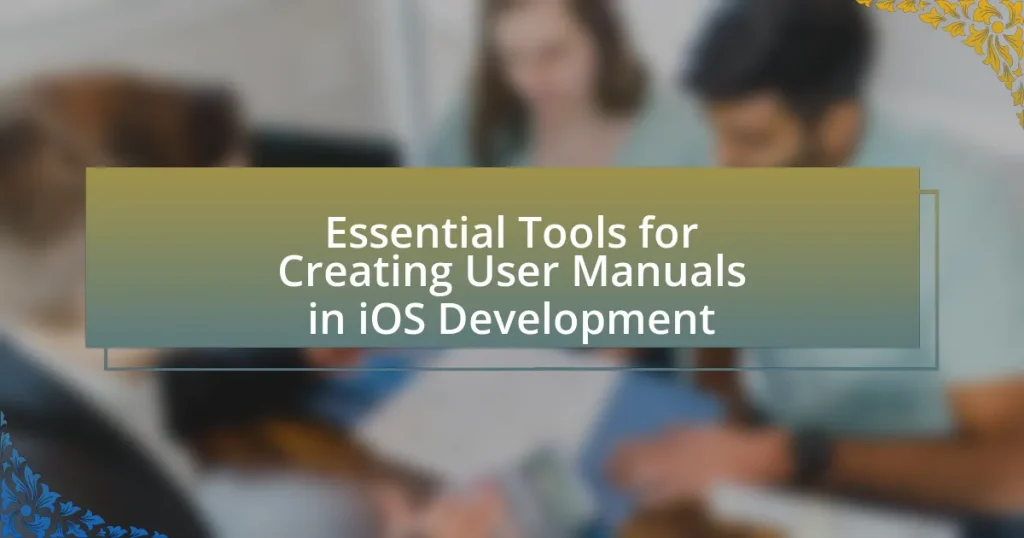The article focuses on the essential tools for creating user manuals in iOS development, highlighting key software such as Xcode, Apple’s documentation tools, Markdown editors, and graphic design applications like Sketch and Adobe XD. It discusses how these tools enhance the manual creation process by improving collaboration, ensuring consistency, and streamlining content development. Specific features of these tools, such as integrated documentation generation and support for multimedia content, are examined for their impact on user experience. Additionally, the article addresses the importance of selecting appropriate tools, the challenges faced without them, and best practices for effective documentation.

What are the Essential Tools for Creating User Manuals in iOS Development?
The essential tools for creating user manuals in iOS development include Xcode, Apple’s documentation tools, Markdown editors, and graphic design software like Sketch or Adobe XD. Xcode serves as the primary integrated development environment (IDE) for iOS applications, allowing developers to create and manage documentation directly within their projects. Apple’s documentation tools, such as Dash or the built-in documentation viewer, provide access to extensive API references and guidelines, which are crucial for accurate manual creation. Markdown editors facilitate the writing process by allowing developers to format text easily, while graphic design software aids in creating visual elements that enhance the user manual’s clarity and appeal. These tools collectively ensure that user manuals are comprehensive, user-friendly, and aligned with iOS development standards.
How do these tools enhance the user manual creation process?
These tools enhance the user manual creation process by streamlining content development, improving collaboration, and ensuring consistency. For instance, tools like Markdown editors allow for easy formatting and quick updates, while collaborative platforms enable multiple contributors to work simultaneously, reducing the time needed for revisions. Additionally, version control features help maintain consistency across different manual versions, ensuring that users always access the most accurate information. This efficiency leads to faster production times and higher-quality manuals, ultimately benefiting both developers and end-users.
What specific features do these tools offer for iOS developers?
These tools offer features such as integrated documentation generation, user-friendly interfaces for creating manuals, and support for multimedia content. Integrated documentation generation allows iOS developers to automatically create user manuals from code comments, ensuring that documentation is always up-to-date with the latest code changes. User-friendly interfaces simplify the process of manual creation, enabling developers to focus on content rather than formatting. Additionally, support for multimedia content, including images and videos, enhances the manuals, making them more engaging and informative for users.
How do these features improve user experience?
These features enhance user experience by providing clear, accessible, and interactive guidance throughout the iOS development process. For instance, integrated search functionalities allow users to quickly locate specific information, reducing frustration and saving time. Additionally, visual aids such as screenshots and videos facilitate better understanding of complex concepts, which is supported by studies showing that visual learning can increase retention rates by up to 65%. Furthermore, user-friendly interfaces streamline navigation, making it easier for developers to find relevant tools and resources, ultimately leading to more efficient workflows and improved satisfaction.
Why is it important to use the right tools for user manuals?
Using the right tools for user manuals is crucial because they enhance clarity, accuracy, and usability of the documentation. Effective tools streamline the creation process, allowing developers to produce manuals that are easy to understand and navigate, which is essential for user satisfaction and product adoption. For instance, tools that support multimedia elements can provide visual aids, making complex information more digestible. Research indicates that well-structured user manuals can reduce support calls by up to 30%, demonstrating the tangible benefits of using appropriate tools in documentation.
What challenges do developers face without proper tools?
Developers face significant challenges without proper tools, including decreased productivity, increased errors, and difficulty in collaboration. The absence of efficient tools can lead to time-consuming manual processes, which hinder the ability to deliver projects on schedule. For instance, a study by the Project Management Institute found that 70% of projects fail due to poor communication and collaboration, often exacerbated by inadequate tools. Additionally, without proper debugging and testing tools, developers are more likely to introduce bugs into their code, which can result in costly fixes and delays. Overall, the lack of appropriate tools directly impacts the quality and efficiency of software development.
How can the right tools streamline the documentation process?
The right tools can streamline the documentation process by automating repetitive tasks and enhancing collaboration among team members. For instance, tools like Markdown editors and documentation generators allow developers to write and format content efficiently, reducing the time spent on manual formatting. Additionally, cloud-based platforms enable real-time collaboration, ensuring that all stakeholders can contribute and review documentation simultaneously, which minimizes errors and accelerates the approval process. Research indicates that teams using collaborative documentation tools can reduce project timelines by up to 30%, demonstrating the effectiveness of these tools in improving workflow efficiency.
What types of tools are available for user manual creation?
Various tools are available for user manual creation, including documentation software, authoring tools, and content management systems. Documentation software like MadCap Flare and Adobe RoboHelp allows for structured content creation and easy updates. Authoring tools such as Snagit and Camtasia enable the integration of visuals and screen captures, enhancing user understanding. Content management systems like WordPress and Confluence facilitate collaborative writing and version control, ensuring that manuals are up-to-date and accessible. These tools are widely used in the industry, demonstrating their effectiveness in producing high-quality user manuals.
What are the differences between text editors and specialized documentation tools?
Text editors and specialized documentation tools differ primarily in their functionality and intended use. Text editors, such as Notepad or Sublime Text, are designed for basic text manipulation and coding, offering features like syntax highlighting and simple formatting. In contrast, specialized documentation tools, like Markdown editors or documentation generators, provide advanced features tailored for creating structured documents, including templates, version control, and collaborative editing capabilities. These tools often support specific formats like Markdown or LaTeX, enabling users to produce professional-quality documentation efficiently. The distinction is evident in their applications; text editors are suitable for coding and quick notes, while specialized documentation tools are essential for comprehensive documentation projects, ensuring clarity and consistency in user manuals.
How do collaborative tools impact the user manual development process?
Collaborative tools significantly enhance the user manual development process by facilitating real-time communication and feedback among team members. These tools enable multiple contributors to work simultaneously on documents, ensuring that updates and revisions are instantly visible, which accelerates the overall development timeline. For instance, platforms like Google Docs allow for simultaneous editing and commenting, which can lead to a more cohesive and accurate final product. Research indicates that teams using collaborative tools can reduce project completion time by up to 30%, demonstrating their effectiveness in streamlining workflows and improving productivity in user manual creation.
How can developers choose the best tools for their needs?
Developers can choose the best tools for their needs by assessing their specific project requirements, evaluating tool features, and considering user feedback. First, identifying the unique needs of the project, such as documentation style, target audience, and integration capabilities, helps narrow down options. Next, comparing features like ease of use, customization, and support for multimedia elements ensures the selected tool aligns with those needs. Finally, reviewing user feedback and case studies provides insights into the effectiveness and reliability of the tools, guiding developers toward informed decisions. For instance, tools like Xcode and Markdown editors are popular among iOS developers for their robust features and community support, demonstrating their effectiveness in creating user manuals.
What criteria should be considered when selecting documentation tools?
When selecting documentation tools, consider usability, integration capabilities, collaboration features, and support for various formats. Usability ensures that the tool is user-friendly, allowing team members to create and edit documentation efficiently. Integration capabilities are crucial for seamless connectivity with other software used in iOS development, such as version control systems and project management tools. Collaboration features facilitate teamwork, enabling multiple users to work on documentation simultaneously and track changes effectively. Support for various formats, including Markdown, HTML, and PDF, ensures that the documentation can be easily shared and accessed across different platforms. These criteria are essential for enhancing productivity and ensuring the documentation meets the needs of both developers and end-users.
How can user feedback influence tool selection?
User feedback significantly influences tool selection by providing insights into user needs and preferences, which can guide developers in choosing the most effective tools for creating user manuals. For instance, feedback can highlight specific features that users find beneficial, such as ease of use or integration capabilities, leading to a more informed decision-making process. Research indicates that organizations that actively incorporate user feedback into their tool selection process experience higher satisfaction rates and improved usability outcomes, as evidenced by a study published in the Journal of Usability Studies, which found that 70% of users preferred tools that had been refined based on their input.
What are the best practices for using these tools effectively?
The best practices for using tools effectively in creating user manuals for iOS development include understanding the tool’s features, maintaining consistency in style and formatting, and incorporating user feedback. Familiarity with the specific functionalities of tools like Xcode, Sketch, or Markdown editors enhances productivity and ensures that developers utilize all available features. Consistency in style and formatting across the manual improves readability and user experience, as evidenced by studies showing that standardized documentation leads to better user comprehension. Additionally, actively seeking and integrating user feedback allows for continuous improvement of the manuals, aligning them more closely with user needs and preferences.
How can developers ensure consistency in their user manuals?
Developers can ensure consistency in their user manuals by establishing a standardized template and style guide. This approach provides a uniform structure for all documentation, including headings, fonts, and terminology. By adhering to a style guide, developers can maintain consistent language and formatting throughout the manual, which enhances readability and user comprehension. Research indicates that consistent documentation can improve user satisfaction and reduce support queries, as users find it easier to navigate and understand the material.
What common pitfalls should be avoided when creating user manuals?
Common pitfalls to avoid when creating user manuals include using overly technical language, which can alienate users unfamiliar with jargon. Additionally, failing to organize content logically can lead to confusion, making it difficult for users to find necessary information. Inadequate visuals, such as diagrams or screenshots, can hinder understanding, as users often benefit from visual aids. Lastly, neglecting to update manuals regularly can result in outdated information, which diminishes the manual’s usefulness. These pitfalls can significantly impact user experience and comprehension, making it essential to address them during the manual creation process.
What are some practical tips for creating effective user manuals in iOS development?
To create effective user manuals in iOS development, focus on clarity, organization, and user-centric design. Clear language ensures that users understand instructions without confusion, while a well-organized structure allows for easy navigation through the manual. Incorporating visuals, such as screenshots and diagrams, enhances comprehension and engagement. Additionally, using consistent terminology throughout the manual helps users familiarize themselves with the content. Testing the manual with actual users can provide valuable feedback, ensuring that the instructions are practical and effective. These strategies are supported by usability studies, which indicate that clear and organized documentation significantly improves user satisfaction and reduces support requests.











